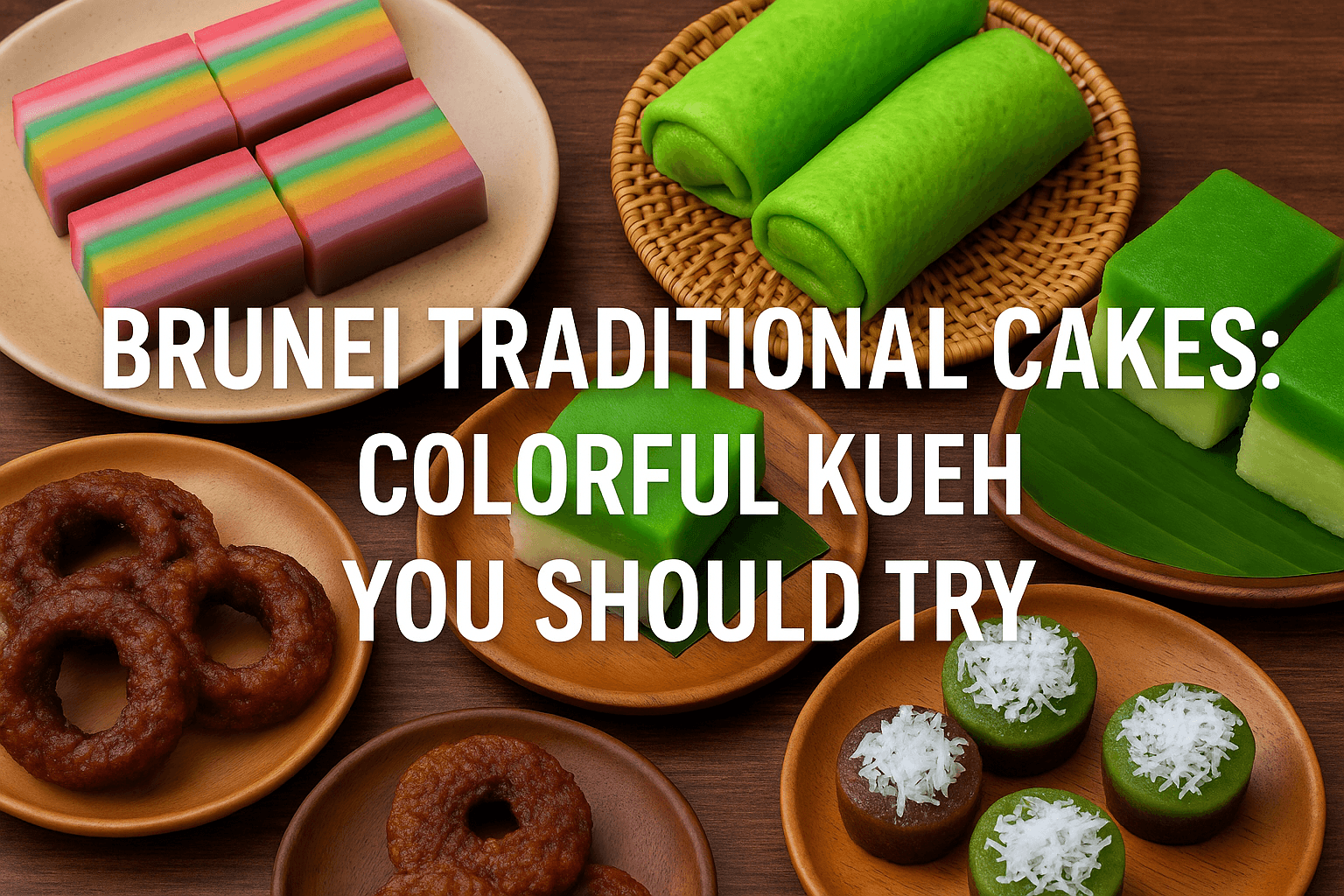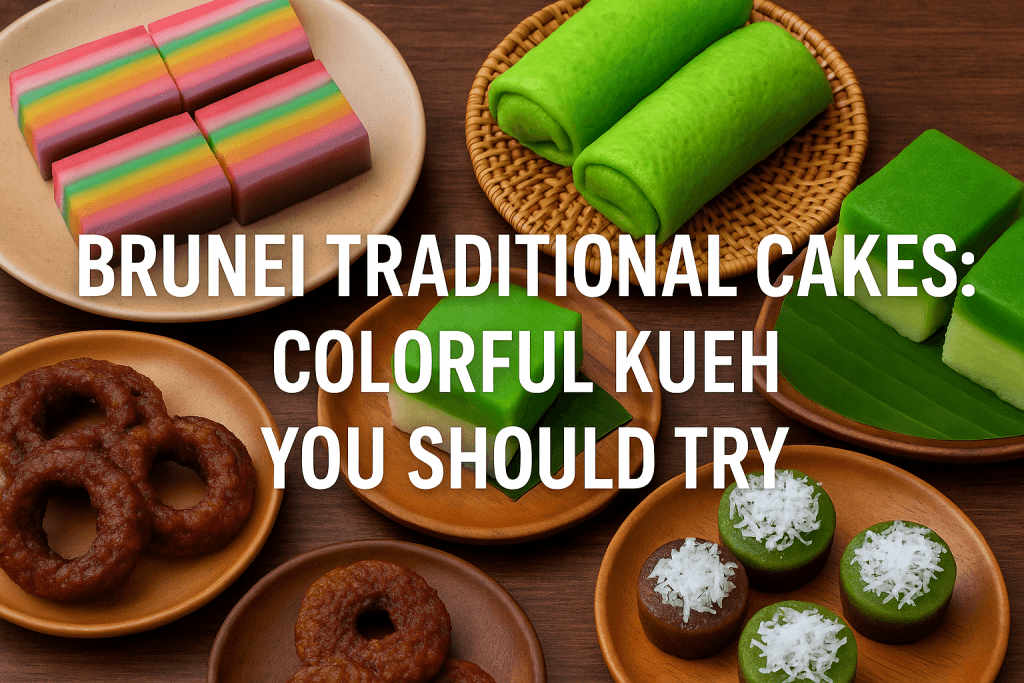When people think about Brunei, their minds often wander to mosques, oil wealth, and pristine rainforests. Yet hidden within this Southeast Asian gem lies a vibrant culinary culture that shines through its sweets and pastries. Among the most captivating highlights are Brunei Traditional Cakes: Colorful Kueh You Should Try. These bite sized delights are not only treats for the palate but also visual wonders that reflect heritage, artistry, and community spirit.
The culinary identity of Brunei is deeply rooted in Malay traditions, blended with Chinese and Indian influences. Nowhere is this more evident than in the local cakes known as kueh. These colorful creations symbolize celebration, sharing, and family gatherings. For food lovers, diving into the world of Brunei Traditional Cakes: Colorful Kueh You Should Try offers an unforgettable journey through textures, aromas, and vibrant aesthetics.
In this article, we will explore the fascinating range of traditional cakes, their cultural relevance, preparation techniques, and the reasons they hold such a strong presence in Bruneian dining. Whether you are a traveler or a culinary enthusiast, these cakes promise to be an enriching experience that extends beyond mere indulgence.

The Cultural Importance of Traditional Cakes in Brunei
Traditional cakes in Brunei go far beyond sweet cravings. They represent cultural continuity, passed down through generations. Every piece of Brunei Traditional Cakes: Colorful Kueh You Should Try carries history and values. These cakes are integral to weddings, religious celebrations, community events, and daily life.
During Ramadan, for instance, families prepare or purchase kueh to break their fast. Each brightly colored piece contributes not only to nourishment but also to the sense of togetherness. On festive occasions like Hari Raya Aidilfitri, tables overflow with assortments of traditional cakes, emphasizing hospitality and generosity.
Beyond festivities, kueh remain a daily snack, enjoyed with tea or coffee. This routine consumption shows that Brunei Traditional Cakes: Colorful Kueh You Should Try are not seasonal indulgences but ingrained cultural staples.
The Unique Characteristics of Brunei Traditional Cakes
What makes these cakes so captivating is their diversity. They differ in color, shape, texture, and flavor, reflecting the artistic ingenuity of Bruneian culinary culture. While some are soft and chewy, others are steamed, layered, or fried to crispy perfection. The natural ingredients range from coconut milk and pandan leaves to palm sugar, rice flour, and glutinous rice.
The emphasis on natural colorings such as pandan green, turmeric yellow, or butterfly pea blue highlights Brunei’s preference for organic aesthetics. The brilliance of Brunei Traditional Cakes: Colorful Kueh You Should Try lies in their ability to simultaneously please the eyes and the taste buds.
Popular Types of Traditional Cakes in Brunei
1. Kueh Lapis
This layered cake exemplifies patience and skill. Each layer of colored batter is steamed individually, creating a rainbow effect. Eating it often involves peeling off the layers, turning the process into a playful yet delicious experience.
2. Kueh Seri Muka
A combination of glutinous rice and custard topping infused with pandan essence. The contrasting textures of sticky rice and creamy topping make it a local favorite.
3. Kueh Talam
A two layered steamed cake where one part is infused with coconut and the other with palm sugar. Its flavor balance of sweet and savory represents Brunei’s cultural fusion.
4. Kueh Bingka
Made from tapioca and coconut milk, this dense cake offers a chewy yet tender texture. Baked until the top caramelizes, it is a must try.
5. Kueh Dadar
A rolled pancake colored green with pandan and filled with sweet coconut. Its visual appeal matches its addictive taste.
6. Kuih Cincin
This ring shaped fried cake has a crunchy texture and a caramel like flavor, making it popular in Bruneian households.
7. Kueh Kosui
A steamed rice cake made with palm sugar, topped with grated coconut. Its softness and aroma make it distinct.
8. Kueh Koci
A glutinous rice cake filled with sweet coconut, wrapped in banana leaves. The natural packaging enhances both flavor and aroma.
Colors and Symbolism in Traditional Cakes
The colors of Brunei Traditional Cakes: Colorful Kueh You Should Try are not arbitrary. Each hue carries meaning. Green often represents freshness and nature, derived from pandan leaves. Yellow signifies prosperity, often from turmeric or egg yolks. Brown shades from palm sugar symbolize richness.
This colorful spectrum reflects celebration and optimism. Presenting a plate of multi hued kueh is akin to presenting a palette of joy, embodying Brunei’s values of warmth and togetherness.
Techniques Behind the Making of Traditional Cakes
Preparing these cakes involves time tested methods. Steaming, baking, and frying are common, but steaming dominates due to its ability to preserve moisture and bring out flavors. Coconut milk is a recurring element, offering creaminess, while palm sugar adds depth.
Grinding rice into flour, squeezing pandan leaves for extract, or wrapping dough in banana leaves reflects the artisanal nature of these creations. The process emphasizes patience, an important cultural value in Bruneian households.
Why Travelers Should Experience Brunei Traditional Cakes
For travelers, exploring Brunei Traditional Cakes: Colorful Kueh You Should Try is a gateway to cultural immersion. Food is one of the most authentic ways to understand a society, and Brunei’s kueh offer insights into history, resourcefulness, and artistry.
Sampling these cakes allows visitors to taste the blending of Malay heritage with local innovations. It also supports small vendors and home based artisans who continue to preserve this tradition.
Health and Natural Ingredients
One appealing factor is the reliance on natural ingredients. Unlike heavily processed sweets, these cakes use rice, tapioca, coconut, palm sugar, and natural colorings. While they are still indulgent, the authenticity of Brunei Traditional Cakes: Colorful Kueh You Should Try lies in their connection to nature.
The Social Aspect of Sharing Cakes
In Brunei, offering cakes to guests is a gesture of hospitality. Sharing kueh is symbolic of friendship and goodwill. Families bond over preparing these sweets, and communities strengthen through collective enjoyment.
Brunei Traditional Cakes in Modern Context
Modern culinary trends have embraced innovation without erasing tradition. Some vendors experiment with new flavors like chocolate, coffee, or cheese, integrating them into the structure of kueh. This modernization ensures that Brunei Traditional Cakes: Colorful Kueh You Should Try remain relevant for younger generations.
At the same time, traditional recipes remain protected by elders who view them as heritage treasures. This balance between tradition and innovation sustains the cakes’ cultural importance.
Influence of Neighboring Cuisines
Brunei shares borders and cultural ties with Malaysia and Indonesia. Thus, similarities exist among regional kueh varieties. However, Bruneian versions often have unique twists, whether in texture, flavor balance, or presentation. This makes exploring Brunei Traditional Cakes: Colorful Kueh You Should Try a distinct experience.
Aesthetic Presentation and Photography Value
The vibrant colors and creative shapes make these cakes highly photogenic. Food bloggers, travelers, and culinary enthusiasts are drawn to them for their Instagram worthy appeal. Presenting plates of colorful kueh enhances their role as cultural ambassadors.
Conclusion
The world of Brunei Traditional Cakes: Colorful Kueh You Should Try is vast, diverse, and deeply meaningful. These cakes are not just food items but cultural symbols, combining history, artistry, and community spirit. From the layered beauty of kueh lapis to the fragrant delight of kueh dadar, each bite is an exploration of Brunei’s identity.
For anyone visiting the country, indulging in these traditional cakes is a must. They provide a sensory journey that combines taste, color, and cultural understanding. The legacy of Brunei’s traditional cakes continues to thrive, ensuring that future generations will savor both the flavors and the values they embody.

